Description
Environmental Remediation Technologies for Metal-Contaminated Soils, Softcover reprint of the original 1st ed. 2016
Coordinators: Hasegawa Hiroshi, Rahman Ismail Md. Mofizur, Rahman Mohammad Azizur
Language: English
Subject for Environmental Remediation Technologies for...:
Publication date: 10-2015
Support: Print on demand
Publication date: 08-2016
Support: Print on demand
Description
/li>Contents
/li>Comment
/li>
This book presents a comprehensive and detailed description of remediation techniques for metal-contaminated soils derived from both natural processes and anthropogenic activities. Using a methodical, step-by-step presentation, the book starts by overviewing the origin of toxicants and the correlated comparative extent of contamination to the environment. The legal provisions as proposed or applied in different countries are then discussed to explain the global regulatory situation regarding soil contamination and the extent of consequent concern. The core part of this publication describes the major techniques for in situ or ex situ treatment of the contaminated soil to meet the regulatory limits. Finally, risk evaluation is incorporated, giving special attention to possible impacts during or after implementation of the remediation strategies.
The intrusion of metals in soils mostly occurs from various anthropogenic activities, e.g., agricultural practices, industrial activities, and municipal waste disposal. The volumes of metal-contaminated soil are becoming greater than before and are ever-increasing due to rapid urbanization, intensified industrialization, and/or population booms in certain parts of the world. Hence, the options previously proposed, such as isolation of the contaminated site or movement of the contaminated mass to a secure disposal site after excavation, are becoming unsuitable from the economic point of view, and instead, decontamination alternatives are preferred. This book will help readers such as scientists and regulators to understand the details of the remediation techniques available to deal with the soils contaminated by toxic metals.
Chapter1 The effects of soil properties to the extent of soil contamination with metals.- Chapter2 Heavy metals accumulation in coastal sediments.- Chapter3 Radionuclides released from nuclear accidents: distribution and dynamics in soil.- Chapter4 Test methods for the evaluation of heavy metals in contaminated soil.- Chapter5 Soil Contamination and Remediation Measures: Revisiting the Relevant Laws and Institutions.- Chapter6 Solidification/Stabilization: A Remedial Option for Metal-Contaminated Soils.- Chapter7 Immobilization of Fluoride and Heavy-metals in Polluted Soil.- Chapter8 Phytoremediation of toxic metals in soils and wetlands: concepts and applications.- Chapter9 Chemical-Induced Washing Remediation of Metal-Contaminated Soils.- Chapter10 Application of Nanotechnology to Remediate Contaminated Soils.- Chapter11 Risk evaluation for remediation techniques to metal-contaminated soils.
Is a unique combination of the remediation techniques available for toxic metal-contaminated soils and the risk factors involved
Incorporates legislative information useful for researchers to evaluate newly designed remediation approaches or to derive an appropriate schematic plan
Provides pros and cons of each remediation method which will be helpful for the selection of the most appropriate technique
Includes supplementary material: sn.pub/extras

